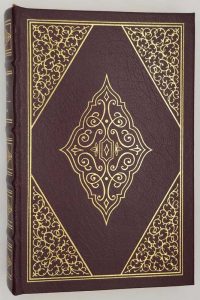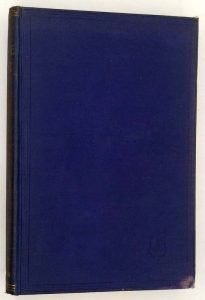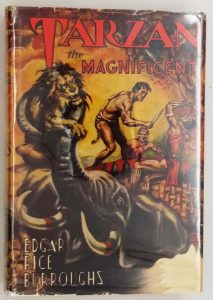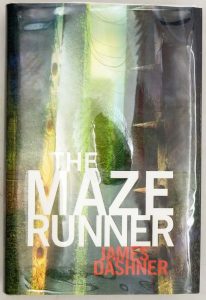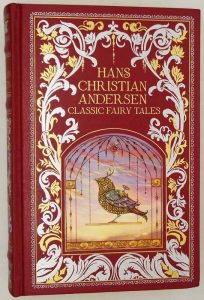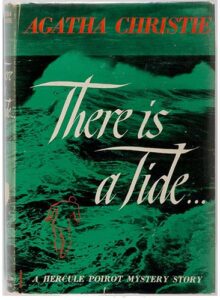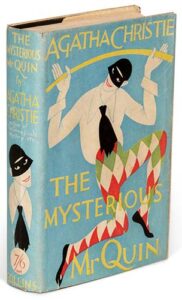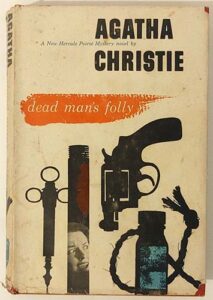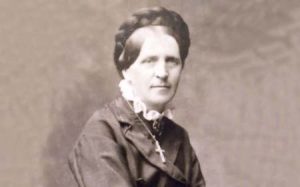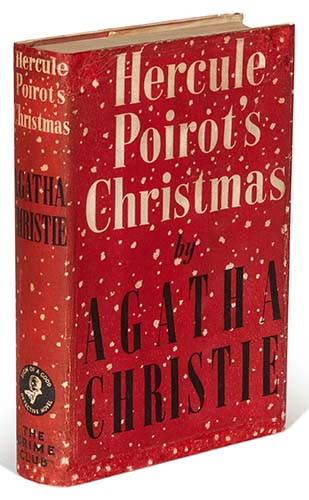
Hercule Poirot’s Christmas is a work of detective fiction by British writer Agatha Christie, first published in the UK by the Collins Crime Club on 19 December 1938 (although the first edition is copyright dated 1939). It retailed at seven shillings and sixpence (7/6).
It was published in US by Dodd, Mead and Company in February 1939 under the title of Murder for Christmas. This edition retailed at $2.00. A paperback edition in the US by Avon books in 1947 changed the title again to A Holiday for Murder. The book features the Belgian detective Hercule Poirot and is a locked room mystery. The premise is a family reuniting for Christmas, and they find the host of the gathering murdered in a private room.
Like Appointment with Death (1938) before it, this is a novel in which the parent/victim was a sadistic tyrant, whose nature leads directly to his/her murder. This theme arises in later Christie works, such as Crooked House (1949) and Ordeal by Innocence (1958).
In some editions, the novel is headed by an epigraph from Macbeth that appears repeatedly in the novel itself: “Yet who would have thought the old man to have had so much blood in him?”, a statement made by Simeon Lee’s daughter-in-law, Lydia, after Simeon’s corpse is found by his family.
The character of Colonel Johnson previously appeared in Three Act Tragedy (1935) and he mentions that case in Part 3 of this novel.
Plot Summary
[SPOILER ALERT]
Multi-millionaire Simeon Lee, frail in his old age, unexpectedly invites his family to gather at his home for Christmas. The gesture is met with suspicion by the guests. Simeon is not given to warm family sentiment, and the family are not on good terms, in particular, with the black sheep of the family, Harry. Simeon also searched out his orphaned, Spanish-born granddaughter, Pilar Estravados, to live in his house. None have met their late sister Jennifer’s daughter before; she proves to be delightful. Simeon is intent on playing a cruel game with his family’s emotions. Stephen Farr, a surprise guest, arrives on Christmas Eve. He is the son of Simeon’s former partner in the diamond mines, welcomed warmly by Simeon. Simeon calls his family together that afternoon, to hear him on the telephone with his attorney, saying he wants to update his will after Christmas. This incomplete information stirs up negative feelings among his sons and their wives.
After dinner on Christmas Eve, the sounds of crashing of furniture and a hideous scream are heard by several, who rush to Simeon’s room. When they get to his door, they find it locked and have to break it down. The sight revealed includes heavy furniture overturned, crockery smashed, and Simeon dead, his throat slit, in a great pool of blood, a grisly and shocking sight. The local police superintendent is already at the front door, before anyone could call the police. Superintendent Sugden notices Pilar pick up something from the floor. He insists that she give the small bit of rubber and a small object made of wood to him.
Sugden explains that he is at the house by prior arrangement with the victim, who confided to him the theft of a substantial quantity of uncut diamonds from his safe. Poirot accompanies Colonel Johnson to investigate this murder. The murder generates many questions. How was the victim killed inside a locked room? Was the murder connected to the theft of the diamonds? And what is the significance of the small triangle of rubber and the peg first noticed by Pilar?
Poirot’s investigation explores the victim’s methodical and vengeful nature and the way these characteristics come out in his sons, and observes physical traits as well. Each son, and perhaps one of the wives, appears as a suspect to the investigators. When the butler mentions his confusion about the identities of the house guests, Poirot realises that the four sons of Simeon’s marriage may not be Simeon’s only sons present in the home. Poirot finds the uncut diamonds mixed in with the stones of a decorative outdoor garden, which takes theft away as a motive. The family lawyer reads Simeon’s will, which leaves half to son Alfred, who runs the business, and the other half to be split among his other children. This leaves Pilar with nothing, as her mother died a year earlier, and his granddaughter is not specifically named. Alfred, David and Harry agree to pool their inheritances and make a share for Pilar. This warm gesture, based on what is just, as Lydia tells her, upsets Pilar, and she refuses it. The final major clue comes from Pilar. She and Stephen are playing with balloons and one bursts; she mentions that the pieces are like what she found on the floor after Simeon Lee was killed. Poirot warns her to be “on her guard”, as she knows more than she realises. Soon she is almost killed in another murder attempt, of a stone cannonball perched above her bedroom door.
A cable comes from South Africa reporting that the son of Simeon’s partner was dead; Stephen Farr admits his name is Stephen Grant, and he is in England to meet his father, from Simeon’s last trip to South Africa, five years after his marriage in England. After that, Pilar reveals the story of the death of the real Pilar as the two crossed Spain during its civil war, and her own plan to arrive in England in her stead. With this knowledge, Sugden tries to blame the murder on Pilar. Then Poirot takes over and explains the crime. Poirot reveals that Sugden was another illegitimate child of Simeon, from an affair with a local girl. Sugden hated the man who abandoned his mother, paying her off. Sugden planned his revenge carefully and murdered his father hours before he set off the noisy sound effects.
David is relieved of his years of anger toward his father for mistreating his mother. Stephen takes Pilar, now Conchita Lopez, to South Africa, to marry her. Lydia will invite them to a proper English Christmas. Alfred and Lydia plan to sell off their old house to forget about the horrible murder. Alfred offers his legitimate brother David his mother’s furniture, but David politely refuses. Other brothers including David leave the house one by one (Harry, David, George). Alfred and Lydia are a little sorry to leave Lydia’s miniature gardens created in stone sinks. Lydia plans another miniature garden she will make in the future. Alfred wholeheartedly thanks his wife for serving him, but Lydia says that it was her duty as a wife.
The story ends with a conversation between Poirot and Colonel Johnson, Chief Constable of the county, by a wood fire. Poirot declares that he much prefers central heating
Publication history
- 1938, Collins Crime Club (London), 19 December 1938, Hardback, 256 pp
- 1939, Dodd Mead and Company (New York), (under the title Murder for Christmas, February 1939, Hardback, 272 pp
- 1947, Avon Books, Paperback, Avon number 124, under the title A Holiday For Murder, 255 pp
- 1957, Fontana Books (Imprint of HarperCollins), Paperback, 189 pp
- 1962, Bantam Books, Paperback, 167 pp 1967, Pan Books, Paperback, 204 pp
- 1972, Fontana Books, Paperback, 189 pp
The book was first serialised in the US in Collier’s Weekly in ten parts from 12 November 1938 (Volume 102, Number 20) to 14 January 1939 (Volume 103, Number 2) under the title Murder For Christmas with illustrations by Mario Cooper.
The UK serialisation was in twenty parts in the Daily Express from Monday, 14 November to Saturday, 10 December 1938 under the title of Murder at Christmas. Most of the instalments carried an uncredited illustration. This version did not contain any chapter divisions.
Hercule Poirot’s Christmas – First Edition Book Identification Guide
The books are listed in the order of publication. While the majority of Agatha Christie’s books were first published in the UK. There are many titles that were first published in the US. The title of the book may differs from the UK edition in some cases.
| Year | Title | Publisher | First edition/printing identification points |
|---|---|---|---|
| 1938 | Hercule Poirot's Christmas | William Collins & Sons, London, [1939] | First edition. "Copyright 1939" stated on the copyright page. No statement of later printings. Red or orange cloth lettered in black. Published in December 1938, but copyright dated 1939. Price 7/6. |
| 1939 | Murder for Christmas | Dodd, Mead & Co, NY, 1939 | First American edition. Date on the title & copyright page matches. No statement of later printings. Decorative black cloth, lettered in green. Price $2.00 |
Note about Book Club Editions (BCE) and reprints:
UK: You can see statements of later reprint dates or of book club on the copyright page.
US: The US reprint publishers usually use the same sheets as the first edition and are harder to identify by looking at the title page or the copyright page. One may identify a BCE by looking at the DJ, which doesn’t have a price on top of the front flap and a “Book Club Edition” imprint at the bottom. If the dust jacked is clipped at both the top/bottom of the front flap. You can safely assume it’s a BCE . If the book is missing the dust jacket. Later BCE editions can be identified by its plain boards, while first printings are issued in quarter cloth.
Please refer to the gallery for detailed images of true first edition bindings and dust jackets.
Hercule Poirot’s Christmas – First Edition Dust Jacket Identification Guide
First edition bindings and various dust jacket printings identification.
